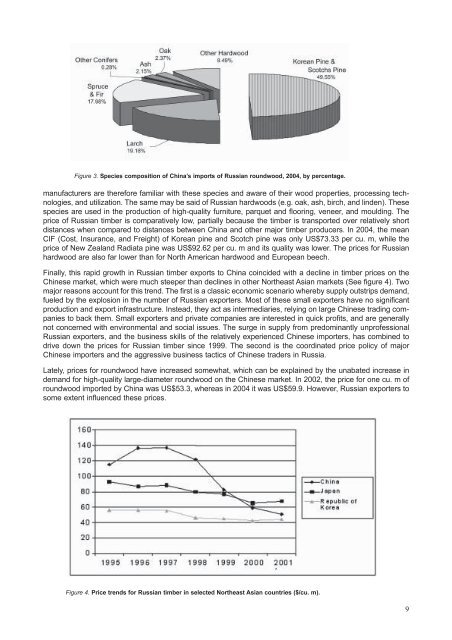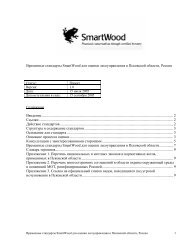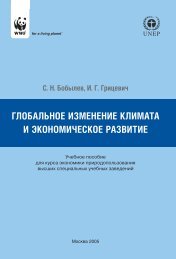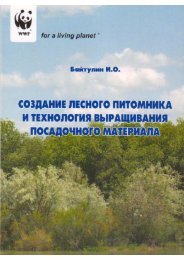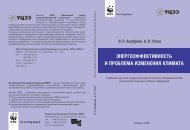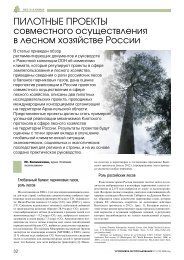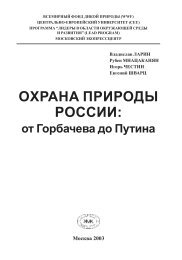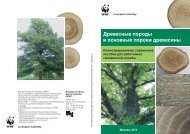Figure 3. Species composition of <strong>China</strong>’s imports of <strong>Russia</strong>n roundwood, 2004, by percentage.manufacturers are therefore familiar with these species and aware of their wood properties, processing technologies,and utilization. The same may be said of <strong>Russia</strong>n hardwoods (e.g. oak, ash, birch, and linden). Thesespecies are used in the production of high-quality furniture, parquet and flooring, veneer, and moulding. Theprice of <strong>Russia</strong>n timber is comparatively low, partially because the timber is transported over relatively shortdistances when compared to distances between <strong>China</strong> and other major timber producers. In 2004, the meanCIF (Cost, Insurance, and Freight) of Korean pine and Scotch pine was only US$73.33 per cu. m, while theprice of New Zealand Radiata pine was US$92.62 per cu. m and its quality was lower. The prices for <strong>Russia</strong>nhardwood are also far lower than for North American hardwood and European beech.Finally, this rapid growth in <strong>Russia</strong>n timber exports to <strong>China</strong> coincided with a decline in timber prices on theChinese market, which were much steeper than declines in other Northeast Asian markets (See figure 4). Twomajor reasons account for this trend. The first is a classic economic scenario whereby supply outstrips demand,fueled by the explosion in the number of <strong>Russia</strong>n exporters. Most of these small exporters have no significantproduction and export infrastructure. Instead, they act as intermediaries, relying on large Chinese trading companiesto back them. Small exporters and private companies are interested in quick profits, and are generallynot concerned with environmental and social issues. The surge in supply from predominantly unprofessional<strong>Russia</strong>n exporters, and the business skills of the relatively experienced Chinese importers, has combined todrive down the prices for <strong>Russia</strong>n timber since 1999. The second is the coordinated price policy of majorChinese importers and the aggressive business tactics of Chinese traders in <strong>Russia</strong>.Lately, prices for roundwood have increased somewhat, which can be explained by the unabated increase indemand for high-quality large-diameter roundwood on the Chinese market. In 2002, the price for one cu. m ofroundwood imported by <strong>China</strong> was US$53.3, whereas in 2004 it was US$59.9. However, <strong>Russia</strong>n exporters tosome extent influenced these prices.Figure 4. Price trends for <strong>Russia</strong>n timber in selected Northeast Asian countries ($/cu. m).9
Table 4.Chinese import of <strong>Russia</strong>n sawnwood, 2000-2004, (000 cu. m 3 )YearTotal Sawnwoodimport<strong>Russia</strong>nsawnwood<strong>Russia</strong>n marketshare(%)<strong>Russia</strong>Rank2000 3,636 158 4.3 72001 4,040 308 7.6 52002 5,396 552 10.2 42003 5,512 561 10.2 42004 7,134 806 11.3 3<strong>Timber</strong> producing regions and key transport routesIn 2004, twenty-six <strong>Russia</strong>n administrative regions exported forest products to <strong>China</strong>. According to data fromthe State Customs Committee of the <strong>Russia</strong>n Federation, seven regions — Krasnoyarskiy Kray, IrkutskayaOblast, Buryatia, and Chitinskaya Oblast in Eastern Siberia and Amurskaya Oblast, Khabarovskiy Kray, andPrimorskiy Kray in the RFE — made up 96% of the total <strong>Russia</strong>n timber export to <strong>China</strong>. In regions bordering<strong>China</strong>, including Chitinskaya and Amurskaya Oblasts and Jewish Autonomous Oblast, over 98% of their totalroundwood export goes to <strong>China</strong>. In 2004, 787,100 tons of pulp was exported to <strong>China</strong>, mostly from IrkutskayaOblast. Export of paper and cardboard was negligible – 243,800 tons, including 19,000 tons of newspaper,13,100 tons of kraft paper, 185,500 tons of kraft-liner and 20,400 tons of cardboard.According to 2002 Chinese customs statistics, about 83.4 percent (12.04 million cu. m) of the timber importedfrom <strong>Russia</strong> was by railway, with the remainder by ship (14.6% or 2.1 million cu. m) and truck (1.6% or .23million cu. m). <strong>Timber</strong> is collected from across Central <strong>Russia</strong>, Siberia and the RFE and exported to <strong>China</strong> viathree railway routes. The RFE route (33.7% of total rail export to <strong>China</strong>) collects timber from vast areas ofEastern Siberia, the Transbaikal Region, and the southern RFE. The main export point is via the town ofGorodekovo in Primorskiy Kray and then via the Chinese border city of Suifenhe in Heilongjiang Province. TheZabaikalian route (32.6% of the total) exports timber from regions north and east of Lake Baikal, includingIrkutskaya Oblast, Buryatia, and Chitinskaya Oblast. This route crosses the border at town of Zabaikalsk,enters <strong>China</strong>’s Inner Mongolia (city of Manzhouli), and then continues on to Heilongjiang Province or southward.The Siberian route (14.8% of total exports timber from Central <strong>Russia</strong> and Western Siberia, includingKrasnoyarskiy Kray, Irkutskaya Oblast, and Buryatia. The timber is exported via the town of Naushki in Buryatia,across Mongolia, and then to the city of Erlianhot in Inner Mongolia before moving further into central10Table 5.Destination of timber imported from <strong>Russia</strong> in 2004 (cu. m)Chinese Province Sawnwood Roundwood Total Proportion of <strong>Russia</strong>n ImportsInner Mongolia 487,557 8,571,998 9,059,555 50.85%Heilongjiang 194,208 7,001,608 7,195,816 40.39%Jiangsu 402 680,509 680,911 3.82%Liaoning 93,440 254,232 347,672 1.95%Shandong 12,531 198,110 210,641 1.18%Zhejiang 118,545 118,545 0.67%Xinjiang 5,834 103,832 109,666 0.62%Shanghai 3,677 68,571 72,248 0.41%Jilin 1,978 16,835 18,813 0.11%Guangdong 1,325 1,926 3,251 0.02%Tianjin 173 115 288 0.01%Beijing 84 67 151 0.01%Shaanxi 56 56 0.01%Total 801,209 17,016,404 17,817,613 100%


